History of the European Union: Difference between revisions
LibbyD2003 (talk | contribs) Grammer edits |
|||
| Line 21: | Line 21: | ||
{{Main|History of the European Coal and Steel Community (1945–57)}} |
{{Main|History of the European Coal and Steel Community (1945–57)}} |
||
[[File:Royal Air Force Bomber Command, 1942-1945. CL3400.jpg|thumb|After two devastating world wars, the political climate favoured an international unity that could preserve peace in Europe effectively. ([[Hamburg]], after a massive [[Allies of World War II|Allied]] [[Bombing of Hamburg in World War II|bombing in 1943]] in the picture)]] |
[[File:Royal Air Force Bomber Command, 1942-1945. CL3400.jpg|thumb|After two devastating world wars, the political climate favoured an international unity that could preserve peace in Europe effectively. ([[Hamburg]], after a massive [[Allies of World War II|Allied]] [[Bombing of Hamburg in World War II|bombing in 1943]] in the picture)]] |
||
World War II from 1939 to 1945 saw a human and economic catastrophe |
World War II from 1939 to 1945 saw a human and economic catastrophe that hit Europe hardest. It demonstrated the horrors of war, and also of extremism, through [[the Holocaust]] and the [[atomic bombings of Hiroshima and Nagasaki]]. Once again, there was a desire to ensure it could never happen again, particularly with the war giving the world nuclear weapons. Most European countries failed to maintain their [[Great Power]] status, with the exception of the USSR, which became a superpower after World War II and maintained the status for 45 years. This left two rival ideologically opposed superpowers.<ref>[http://www.ena.lu?lang=2&doc=243 Europe in ruins in the aftermath of the Second World War] ena.lu</ref> |
||
To ensure Germany could never threaten the peace again, its heavy industry was partly dismantled (See: [[Allied plans for German industry after World War II]]) and its main coal-producing regions were detached ([[Saarland]], [[Province of Silesia|Silesia]]), or put under international control ([[Ruhr area]]).<ref>*[http://www.ena.lu?lang=2&doc=6584 French proposal regarding the detachment of German industrial regions] 8 September 1945<br />[http://www.american.edu/ted/ice/saar.htm France, Germany and the Struggle for the War-making Natural Resources of the Rhineland][http://www.ena.lu?lang=2&doc=465 Letter from Konrad Adenauer to Robert Schuman] (26 July 1949) Warning him of the consequences of the dismantling policy. (requires Flash Player)<br />[http://www.ena.lu?lang=2&doc=16822 Letter from Ernest Bevin to Robert Schuman] (30 October 1949) British and French foreign ministers. Bevin argues that they need to reconsider the Allies' dismantling policy in the occupied zones (requires Flash Player)</ref> (See: [[Monnet Plan]]) |
To ensure Germany could never threaten the peace again, its heavy industry was partly dismantled (See: [[Allied plans for German industry after World War II]]) and its main coal-producing regions were detached ([[Saarland]], [[Province of Silesia|Silesia]]), or put under international control ([[Ruhr area]]).<ref>*[http://www.ena.lu?lang=2&doc=6584 French proposal regarding the detachment of German industrial regions] 8 September 1945<br />[http://www.american.edu/ted/ice/saar.htm France, Germany and the Struggle for the War-making Natural Resources of the Rhineland][http://www.ena.lu?lang=2&doc=465 Letter from Konrad Adenauer to Robert Schuman] (26 July 1949) Warning him of the consequences of the dismantling policy. (requires Flash Player)<br />[http://www.ena.lu?lang=2&doc=16822 Letter from Ernest Bevin to Robert Schuman] (30 October 1949) British and French foreign ministers. Bevin argues that they need to reconsider the Allies' dismantling policy in the occupied zones (requires Flash Player)</ref> (See: [[Monnet Plan]]) |
||
| Line 44: | Line 44: | ||
Throughout the 1960s tensions began to show with France seeking to limit supranational power and rejecting the membership of the United Kingdom. However, in 1965 an agreement was reached to merge the three communities under a single set of institutions, and hence the [[Merger Treaty]] was signed in Brussels and came into force on 1 July 1967 creating the [[European Communities]].<ref>[http://www.ena.lu?lang=2&doc=473 Merging the executives] ena.lu</ref> [[Jean Rey (politician)|Jean Rey]] [[President of the European Commission|presided over]] the first merged Commission ([[Rey Commission]]). |
Throughout the 1960s tensions began to show with France seeking to limit supranational power and rejecting the membership of the United Kingdom. However, in 1965 an agreement was reached to merge the three communities under a single set of institutions, and hence the [[Merger Treaty]] was signed in Brussels and came into force on 1 July 1967 creating the [[European Communities]].<ref>[http://www.ena.lu?lang=2&doc=473 Merging the executives] ena.lu</ref> [[Jean Rey (politician)|Jean Rey]] [[President of the European Commission|presided over]] the first merged Commission ([[Rey Commission]]). |
||
While the political progress of the Communities was hesitant in the 1960s, this was a fertile period for European legal integration.<ref>Lecourt, Robert (1976). L'Europe des juges. Bruxelles, Bruylant. Stein, Eric (1981). 'Lawyers, Judges and the Making of a Transnational Constitution.' American Journal of International Law 75(1): 1–27. Weiler, Joseph H. H. (1991). 'The Transformation of Europe.' Yale Law Journal 100: 2403–2483.</ref> Many of the foundational legal doctrines of the Court of Justice were first established in landmark decisions during the 1960s and 1970s, above all in the ''[[Van Gend en Loos v Nederlandse Administratie der Belastingen|Van Gend en Loos]]'' decision of 1963 that declared the "direct effect" of European law, that is to say, its enforceability before national courts by private parties.<ref>ECJ Case 26/62</ref> Other landmark decisions during this period included ''[[Costa v ENEL]]'', which established the supremacy of European law over national law<ref>ECJ Case 6/64</ref> and the [[Commission v Luxembourg & Belgium|"Dairy Products" decision]], which declared that general international law principles of reciprocity and retaliation were prohibited within the European Community.<ref>ECJ Cases 90&91/63, Commission v Luxembourg & Belgium. See e.g. Phelan, William (2016). 'Supremacy, Direct Effect, and Dairy Products in the Early History of European law.' International Journal of Constitutional Law 14: 6–25.</ref> All three of these judgments were made after the appointment of French judge [[Robert Lecourt]] in 1962, and Lecourt appears to have become a dominant influence on the Court of Justice over the 1960s and 1970s.<ref>W. Phelan, Great Judgments of the European Court of Justice: Rethinking the Landmark Decisions of the Foundational Period (Cambridge, 2019)</ref> |
While the political progress of the Communities was hesitant in the 1960s, this was a fertile period for European legal integration.<ref>Lecourt, Robert (1976). L'Europe des juges. Bruxelles, Bruylant. Stein, Eric (1981). 'Lawyers, Judges, and the Making of a Transnational Constitution.' American Journal of International Law 75(1): 1–27. Weiler, Joseph H. H. (1991). 'The Transformation of Europe.' Yale Law Journal 100: 2403–2483.</ref> Many of the foundational legal doctrines of the Court of Justice were first established in landmark decisions during the 1960s and 1970s, above all in the ''[[Van Gend en Loos v Nederlandse Administratie der Belastingen|Van Gend en Loos]]'' decision of 1963 that declared the "direct effect" of European law, that is to say, its enforceability before national courts by private parties.<ref>ECJ Case 26/62</ref> Other landmark decisions during this period included ''[[Costa v ENEL]]'', which established the supremacy of European law over national law<ref>ECJ Case 6/64</ref> and the [[Commission v Luxembourg & Belgium|"Dairy Products" decision]], which declared that general international law principles of reciprocity and retaliation were prohibited within the European Community.<ref>ECJ Cases 90&91/63, Commission v Luxembourg & Belgium. See e.g. Phelan, William (2016). 'Supremacy, Direct Effect, and Dairy Products in the Early History of European law.' International Journal of Constitutional Law 14: 6–25.</ref> All three of these judgments were made after the appointment of French judge [[Robert Lecourt]] in 1962, and Lecourt appears to have become a dominant influence on the Court of Justice over the 1960s and 1970s.<ref>W. Phelan, Great Judgments of the European Court of Justice: Rethinking the Landmark Decisions of the Foundational Period (Cambridge, 2019)</ref> |
||
==1973–1993: Enlargement to Delors== |
==1973–1993: Enlargement to Delors== |
||
Revision as of 13:50, 5 July 2020
| History of the European Union |
|---|
 |
|
|
The European Union is a geo-political entity covering a large portion of the European continent. It is founded upon numerous treaties and has undergone expansions and secessions that have taken it from 6 member states to 27, a majority of the states in Europe.
Apart from the ideas of
The
Ideas of European unity before 1945
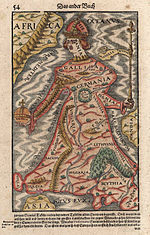
The original development of the European Union was based on a supranational foundation that would "make war unthinkable and materially impossible"[1][2] A peaceful means of some consolidation of European territories used to be provided by
In the Congress of Aix-la-Chapelle of 1818, Tsar Alexander, as the most advanced internationalist of the day, suggested a kind of permanent European union and even proposed the maintenance of international military forces to provide recognised states with support against changes by violence.[5]
An example of an organisation formed to promote the association of states between the wars to promote the idea of European union is the
1945–1957: From ECSC to the Treaties of Rome

World War II from 1939 to 1945 saw a human and economic catastrophe that hit Europe hardest. It demonstrated the horrors of war, and also of extremism, through
To ensure Germany could never threaten the peace again, its heavy industry was partly dismantled (See:
With statements such as
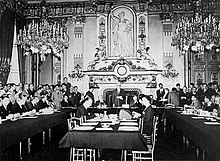
On the basis of that speech, France, Italy, the Benelux countries (Belgium, Netherlands and Luxembourg) together with West Germany signed the Treaty of Paris (1951) creating the European Coal and Steel Community the following year; this took over the role of the International Authority for the Ruhr[8] and lifted some restrictions on German industrial productivity. It gave birth to the first institutions, such as the High Authority (now the European Commission) and the Common Assembly (now the European Parliament). The first presidents of those institutions were Jean Monnet and Paul-Henri Spaak respectively.
The formation of the European Coal and Steel Community was advanced by
The attempt to turn the
After failed attempts at creating defence (
1958–1972: Three communities
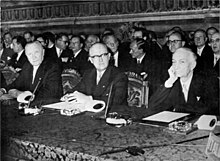
The two new communities were created separately from ECSC, although they shared the same courts and the Common Assembly. The executives of the new communities were called Commissions, as opposed to the "High Authority". The EEC was headed by
Throughout the 1960s tensions began to show with France seeking to limit supranational power and rejecting the membership of the United Kingdom. However, in 1965 an agreement was reached to merge the three communities under a single set of institutions, and hence the Merger Treaty was signed in Brussels and came into force on 1 July 1967 creating the European Communities.[13] Jean Rey presided over the first merged Commission (Rey Commission).
While the political progress of the Communities was hesitant in the 1960s, this was a fertile period for European legal integration.[14] Many of the foundational legal doctrines of the Court of Justice were first established in landmark decisions during the 1960s and 1970s, above all in the Van Gend en Loos decision of 1963 that declared the "direct effect" of European law, that is to say, its enforceability before national courts by private parties.[15] Other landmark decisions during this period included Costa v ENEL, which established the supremacy of European law over national law[16] and the "Dairy Products" decision, which declared that general international law principles of reciprocity and retaliation were prohibited within the European Community.[17] All three of these judgments were made after the appointment of French judge Robert Lecourt in 1962, and Lecourt appears to have become a dominant influence on the Court of Justice over the 1960s and 1970s.[18]
1973–1993: Enlargement to Delors
After much negotiation, and following a change in the French Presidency, Denmark, Ireland and the United Kingdom (with Gibraltar) eventually joined the European Communities on 1 January 1973. This was the first of several enlargements which became a major policy area of the Union (see: Enlargement of the European Union).[19]
In 1979, the European Parliament held its first direct elections by universal suffrage. 410 members were elected, who then elected the first female President of the European Parliament, Simone Veil.[20]
A further enlargement took place in 1981 with Greece joining on 1 January, six years after applying. In 1982,

Recently appointed Commission President

In 1987
With a wave of new enlargements on the way, the Maastricht Treaty was signed on 7 February 1992 which established the European Union when it came into force the following year.
1993–2004: Creation
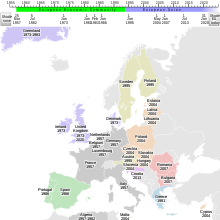
On 1 November 1993, under the third
On 30 March 1994, accession negotiations concluded with
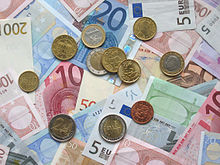
During the 1990s, the
However, any success was overshadowed by the budget crisis in March 1999. The Parliament refused to approve the Commission's 1996 community's budget on grounds of financial mismanagement, fraud and nepotism. With Parliament ready to throw them out, the entire Santer Commission resigned.[33][34] The post-Delors mood of euroscepticism became entrenched with the Council and Parliament constantly challenging the Commission's position in coming years.[35]
In the
2004–present

On 10–13 June 2004, the 25 member states participated in the largest trans-national election in history (with the second largest democratic electorate in the world). The result of the
A proposed
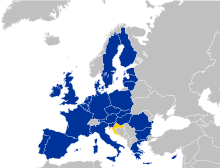
The 2009 elections again saw a victory for the European People's Party, despite losing the British Conservatives who formed a smaller eurosceptic grouping with other anti-federalist right wing parties. Parliament's presidency was once again divided between the People's Party and the Socialists, with Jerzy Buzek elected as the first President of the European Parliament from an ex-communist country. Barroso was nominated by the Council for a second term and received backing from EPP who had declared him as their candidate before the elections. However, the Socialists and Greens led the opposition against him despite not agreeing on an opposing candidate. Parliament finally approved Barroso II, though once more several months behind schedule.
In 2007, the fifth enlargement completed with the accession of Romania and Bulgaria on 1 January 2007. Also, in 2007 Slovenia adopted the euro,[41] Malta and Cyprus in 2008[42] and Slovakia in 2009. However trouble developed with existing members as the eurozone entered its first recession in 2008.[43] Members cooperated and the ECB intervened to help restore economic growth and the euro was seen as a safe haven, particularly by those outside such as Iceland.[44][45][46]
However, with the risk of a default in
The European Union received the 2012 Nobel Peace Prize for having "contributed to the advancement of peace and reconciliation, democracy and human rights in Europe."[50][51] The Nobel Committee stated that "that dreadful suffering in World War II demonstrated the need for a new Europe [...] today war between Germany and France is unthinkable. This shows how, through well-aimed efforts and by building up mutual confidence, historical enemies can become close partners."[52] The Nobel Committee's decision was subject to considerable criticism.[53]
On 1 July 2013, Croatia joined the EU, and on 1 January 2014 the French Indian Ocean territory of Mayotte was added as an outermost region.[54]
On 23 June 2016, the citizens of the United Kingdom voted to withdraw from the European Union in a referendum and subsequently became the first and to date only member to trigger Article 50 of the Treaty on European Union (TEU). The vote was in favour of leaving the EU by a margin of 51.9% in favour to 48.1% against.[55] The UK's withdrawal was completed on 31 January 2020.
See also
- Timeline of European Union history
- Enlargement of the European Union
- History of the euro
- History of the Common Security and Defence Policy
- List of European Councils
- List of presidents of the institutions of the European Union
- Founding fathers of the European Union
- History of the European Union in Brussels
- History of the location of EU institutions
- History of Europe
- House of European History
- Virtual Centre for Knowledge on EuropeMultimedia source collections on EU History
- Wider European history between World War II and the fall of Communism in Europe 1945–1992
- End of World War II in Europe
- Cold War
- Revolutions of 1989
- German reunification
- Yugoslavia and the European Economic Community
- Breakup of Yugoslavia
- Wider European history after the creation of the European Union
- Maastricht Treaty
- History of the European Union (1993–2004)
- History of the European Union (since 2004)
- Eurozone
- 2006 Montenegrin independence referendum
- 2008 Kosovo declaration of independence from Serbia
- European sovereign-debt crisis
References
- ^ a b "Schuman Project". schuman.info.
- ^ a b "Schuman Project". schuman.info.
- ^ "Schuman Project". schuman.info.
- ^ "The World Factbook". cia.gov.
- ^ R. R. Palmer. A History of the Modern World. p. 461.
- ^ Europe in ruins in the aftermath of the Second World War ena.lu
- ^ *French proposal regarding the detachment of German industrial regions 8 September 1945
France, Germany and the Struggle for the War-making Natural Resources of the RhinelandLetter from Konrad Adenauer to Robert Schuman (26 July 1949) Warning him of the consequences of the dismantling policy. (requires Flash Player)
Letter from Ernest Bevin to Robert Schuman (30 October 1949) British and French foreign ministers. Bevin argues that they need to reconsider the Allies' dismantling policy in the occupied zones (requires Flash Player) - ^ "Problem while searching in History". digicoll.library.wisc.edu. Retrieved 28 July 2016.
- ^ "Europe: How The Marshall Plan Took Western Europe From Ruins To Union". RadioFreeEurope/RadioLiberty. Retrieved 20 June 2019.
- ^ a b A peaceful Europe – the beginnings of cooperation europa.eu
- ^ A European Atomic Energy Community ena.lu
- ^ A European Customs Union ena.lu
- ^ Merging the executives ena.lu
- ^ Lecourt, Robert (1976). L'Europe des juges. Bruxelles, Bruylant. Stein, Eric (1981). 'Lawyers, Judges, and the Making of a Transnational Constitution.' American Journal of International Law 75(1): 1–27. Weiler, Joseph H. H. (1991). 'The Transformation of Europe.' Yale Law Journal 100: 2403–2483.
- ^ ECJ Case 26/62
- ^ ECJ Case 6/64
- ^ ECJ Cases 90&91/63, Commission v Luxembourg & Belgium. See e.g. Phelan, William (2016). 'Supremacy, Direct Effect, and Dairy Products in the Early History of European law.' International Journal of Constitutional Law 14: 6–25.
- ^ W. Phelan, Great Judgments of the European Court of Justice: Rethinking the Landmark Decisions of the Foundational Period (Cambridge, 2019)
- ^ The first enlargement cvce.eu
- ^ The new European Parliament cvce.eu
- ^ Negotiations for enlargement cvce.eu
- ^ Single European Act cvce.eu
- ^ Miklós Németh in Interview, Austrian TV - ORF "Report", 25 June 2019
- ^ „Der 19. August 1989 war ein Test für Gorbatschows“ (German - August 19, 1989 was a test for Gorbachev), in: FAZ 19 August 2009.
- ^ Michael Frank: Paneuropäisches Picknick – Mit dem Picknickkorb in die Freiheit (German: Pan-European picnic - With the picnic basket to freedom), in: Süddeutsche Zeitung 17 May 2010.
- ^ Ludwig Greven "Und dann ging das Tor auf", in Die Zeit, 19 August 2014.
- ^ The fall of the Berlin Wall ena.lu
- ^ Andreas Rödder, Deutschland einig Vaterland – Die Geschichte der Wiedervereinigung (2009).
- ^ 1993 europa.eu
- ^ Characteristics of the Treaty on European Union cvce.eu
- Centre Virtuel de la Connaissance sur l'Europe (CVCE). Retrieved 29 January 2013.
- ^ The Treaty of Amsterdam ena.lu
- ^ Ringer, Nils F. (February 2003). "The Santer Commission Resignation Crisis" (PDF). University of Pittsburgh. Retrieved 7 October 2007.
- ISBN 978-0-7190-5666-6.
- ^ Topan, Angelina (30 September 2002). "The resignation of the Santer-Commission: the impact of 'trust' and 'reputation'". European Integration online Papers. Retrieved 7 October 2007.
- ^ "EU Budget Fraud". politics.co.uk. Archived from the original on 19 June 2006. Retrieved 7 October 2007.
- ^ Prodi to Have Wide, New Powers as Head of the European Commission iht.com 16 April 1999
- ^ Javier Solana/Spain: Europe's First Foreign Minister? businessweek.com
- ^ Vote EU 2004 news.bbc.co.uk
- ^ The new commission – some initial thoughts Archived 23 September 2006 at the Wayback Machine bmbrussels.b
- British Broadcasting Corporation. 16 June 2006. Retrieved 18 January 2009.
- euractiv.com. 16 May 2007. Archived from the originalon 18 October 2007. Retrieved 19 January 2009.
- ^ EU data confirms eurozone's first recession Archived 30 December 2010 at the Wayback Machine, EUbusiness.com, 8 January 2009
- ^ "European leaders agree crisis rescue at summit". Eubusiness.com. Archived from the original on 13 October 2008. Retrieved 2 January 2009.
- ^ Oakley, David and Ralph Atkins (17 September 2009) Eurozone shows its strength in a crisis, Financial Times
- ^ Iceland to be fast-tracked into the EU, the Guardian
- ^ Willis, Andrew (25 March 2010) Eurozone leaders agree on Franco-German bail-out mechanism, EU Observer
- ^ Eurozone overhaul Die Zeit on Presseurop, 12 February 2010
- ^ Plans emerge for 'European Monetary Fund' EU Observer
- ^ The Nobel Peace Prize 2012, Nobelprize.org, 12 October 2012, retrieved 12 October 2012
- ^ "Nobel Committee Awards Peace Prize to E.U.", New York Times, 12 October 2012, retrieved 12 October 2012
- ^ The Nobel Peace Prize for 2012, Nobelprize.org, 12 October 2012, retrieved 12 October 2012
- ^ Gaspers, Jan (December 2012). "The European Union and the Nobel Peace Prize: A Criteria-Based Assessment" (PDF). Retrieved 19 December 2012.
- ^ "EUROPEAN COUNCIL DECISION of 11 July 2012 amending the status of Mayotte with regard to the European Union". europa.eu.
- ^ "Labour leadership & Hammond in China – BBC News". Retrieved 23 July 2016.
Further reading
- Anderson, P. The New Old World (Verso 2009) ISBN 978-1-84467-312-4
- Berend, Ivan T.The History of European Integration: A New Perspective. (Routledge, 2016).
- Blair, Alasdair. The European Union since 1945 (Routledge, 2014).
- Chaban, N. and M. Holland, eds. Communicating Europe in Times of Crisis: External Perceptions of the European Union (2014).
- Dedman, Martin. The origins and development of the European Union 1945-1995: a history of European integration (Routledge, 2006).
- De Vries, Catherine E. "Don't Mention the War! Second World War Remembrance and Support for European Cooperation." JCMS: Journal of Common Market Studies (2019).
- Dinan, Desmond. Europe recast: a history of European Union (2nd ed. Palgrave Macmillan), 2004 excerpt.
- Fimister, Alan. Robert Schuman: Neo-Scholastic Humanism and the Reunification of Europe (2008)
- Heuser, Beatrice. Brexit in History: Sovereignty or a European Union? (2019) excerpt also see online review
- Hobolt, Sara B. "The Brexit vote: a divided nation, a divided continent." Journal of European Public Policy (2016): 1–19.
- Jorgensen, Knud Erik, et al., eds. The SAGE Handbook of European Foreign Policy (Sage, 2015).
- Kaiser, Wolfram. "From state to society? The historiography of European integration." in Michelle Cini, and Angela K. Bourne, eds. Palgrave Advances in European Union Studies (Palgrave Macmillan UK, 2006). pp 190–208.
- Kaiser, Wolfram, and Antonio Varsori, eds. European Union history: themes and debates (Springer, 2016).
- Koops, TJ. and G. Macaj. The European Union as a Diplomatic Actor (2015).
- McCormick, John. Understanding the European Union: a concise introduction (Palgrave Macmillan, 2014).
- May, Alex. Britain and Europe since 1945 (1999).
- Marsh, Steve, and Hans Mackenstein. The International Relations of the EU (Routledge, 2014).
- Milward, Alan S.The Reconstruction of Western Europe: 1945–51 (Univ. of California Press, 1984)
- Pasture, Patrick (2015). Imagining European unity since 1000 AD. New York: Palgrave Macmillan. ISBN 9781137480460.
- Patel, Kiran Klaus, and Wolfram Kaiser. "Continuity and change in European cooperation during the twentieth century." Contemporary European History 27.2 (2018): 165–182. online
- Smith, M.L.; Stirk, P.M.R., eds. (1990). Making The New Europe: European Unity and the Second World War (1st UK ed.). London: Pinter Publishers. ISBN 0-86187-777-2.
- Stirk, P.M.R., ed. (1989). European Unity in Context: The Interwar Period (1st ed.). London: Pinter Publishers. ISBN 9780861879878.
- Young, John W. Britain, France, and the unity of Europe, 1945–1951 (Leicester University, 1984).
External links
- History of the EU Official Europa website
- CLIOH-WORLD CLIOH-WORLD: Network of Universities supported by the European Commission (LLP-Erasmus) for the researching, teaching and learning of the history of the EU, including History of EU Integration, EU-Turkey dialogue, and linking to world history.
- An Outline of the Emergence of the European Union
Since the end of World War II, sovereign European countries have entered into treaties and thereby co-operated and harmonised policies (or pooled sovereignty) in an increasing number of areas, in the European integration project or the construction of Europe (French: la construction européenne). The following timeline outlines the legal inception of the European Union (EU)—the principal framework for this unification. The EU inherited many of its present responsibilities from the European Communities (EC), which were founded in the 1950s in the spirit of the Schuman Declaration.
| Legend: S: signing F: entry into force T: termination E: expiry de facto supersession Rel. w/ EC/EU framework: de facto inside outside |
[Cont.] | |||||||||||||||||
| (Pillar I) | ||||||||||||||||||
| European Atomic Energy Community (EAEC or Euratom) | [Cont.] | |||||||||||||||||
(Distr. of competences) | ||||||||||||||||||
| European Economic Community (EEC) | ||||||||||||||||||
| Schengen Rules | European Community (EC) | |||||||||||||||||
'TREVI'
|
||||||||||||||||||
| [Cont.] | Police and Judicial Co-operation in Criminal Matters (PJCC, pillar II )
| |||||||||||||||||
Anglo-French alliance |
[Defence arm handed to NATO] | European Political Co-operation (EPC) | Common Foreign and Security Policy (CFSP, pillar III) | |||||||||||||||
| [Tasks defined following the WEU's 1984 reactivation handed to the EU] | ||||||||||||||||||
| [Social, cultural tasks handed to CoE] | [Cont.] | |||||||||||||||||
Entente Cordiale
S: 8 April 1904 |
Davignon report
S: 27 October 1970 |
European Council conclusions S: 2 December 1975 |
||||||||||||||||
- ^ a b c d e Although not EU treaties per se, these treaties affected the development of the EU defence arm, a main part of the CFSP. The Franco-British alliance established by the Dunkirk Treaty was de facto superseded by WU. The CFSP pillar was bolstered by some of the security structures that had been established within the remit of the 1955 Modified Brussels Treaty (MBT). The Brussels Treaty was terminated in 2011, consequently dissolving the WEU, as the mutual defence clause that the Lisbon Treaty provided for EU was considered to render the WEU superfluous. The EU thus de facto superseded the WEU.
- European Political Community (EPC) were shelved following the French failure to ratify the Treaty establishing the European Defence Community(EDC). The EPC would have combined the ECSC and the EDC.
- ^ The European Communities obtained common institutions and a shared legal personality (i.e. ability to e.g. sign treaties in their own right).
- ^ The treaties of Maastricht and Rome form the EU's legal basis, and are also referred to as the Treaty on European Union (TEU) and the Treaty on the Functioning of the European Union (TFEU), respectively. They are amended by secondary treaties.
- ^ Between the EU's founding in 1993 and consolidation in 2009, the union consisted of three pillars, the first of which were the European Communities. The other two pillars consisted of additional areas of cooperation that had been added to the EU's remit.
- distribution of competencies between EU institutions and member states. This distribution, as well as treaty provisions for policy areas in which unanimity is required and qualified majority voting is possible, reflects the depth of EU integration as well as the EU's partly supranational and partly intergovernmentalnature.
